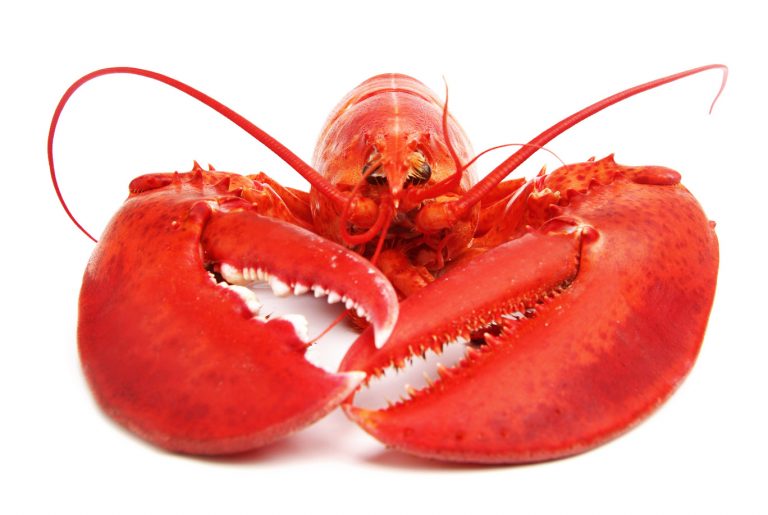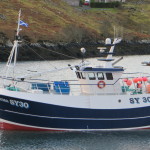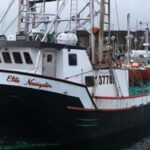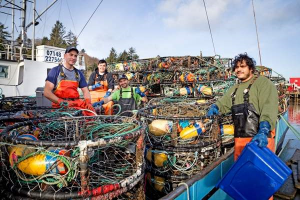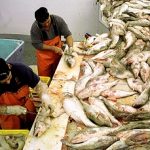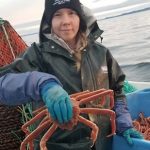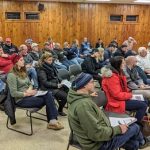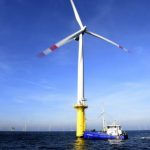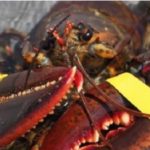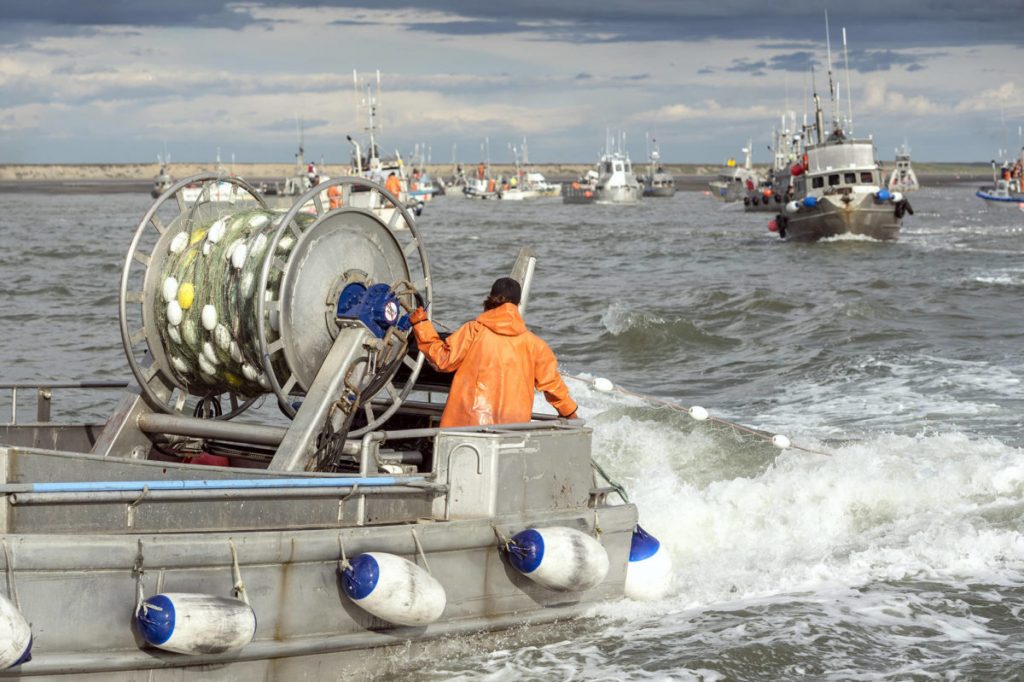Search Results for: North Carolina Fisheries Association
North Carolina Fisheries Association Weekly Update for November 20, 2023
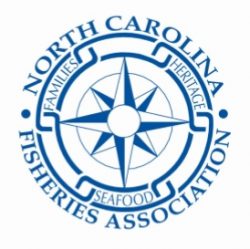 The North Carolina Marine Fisheries Commission (MFC) met last week in Emerald Isle, NC. I am happy to report there was good turnout from fishermen giving comments and talking with commissioners and staff during and after the meeting. As most of you know the striped mullet was the hot item on the agenda. Specifically, looking at reducing striped mullet harvest by setting seasons and trip limits. If you read the Weekly Update last week you know that the Division of Marine Fisheries (DMF) has recommended the maximum harvest reduction percentage of 35.4%. DMF recommends:>>click to read<< 13:45
The North Carolina Marine Fisheries Commission (MFC) met last week in Emerald Isle, NC. I am happy to report there was good turnout from fishermen giving comments and talking with commissioners and staff during and after the meeting. As most of you know the striped mullet was the hot item on the agenda. Specifically, looking at reducing striped mullet harvest by setting seasons and trip limits. If you read the Weekly Update last week you know that the Division of Marine Fisheries (DMF) has recommended the maximum harvest reduction percentage of 35.4%. DMF recommends:>>click to read<< 13:45

North Carolina Fisheries Association Weekly Update: October 23, 2023: The ASMFC
Last week I had a reader who was interested in understanding more about what the Atlantic States Marine Fisheries Commission is and how they fit in with North Carolina fisheries management. The Atlantic States Marine Fisheries Commission (ASMFC) held their 81st Annual Meeting in Beaufort, NC last week. Although no hot button issues were on the agenda last week, a lot of other necessary fisheries management issues were discussed and voted on. In fact, many of the rules and regulations on how North Carolina manages our inshore species comes directly from ASMFC decisions. The ASMFC began in 1942 when the Atlantic Coast States realized that their shared migratory fish stocks would be more sustainable and better managed as coast-wide stocks rather than being managed solely at the state level. This is expressed in the ASMFC vision statement, “Sustainable and Cooperative Management of Atlantic Coastal Fisheries”. >>click to read<<,10: 50

North Carolina Fisheries Association Weekly Update for October 02, 2023
Southern Flounder, Uncertain Baseline Data. This week I wanted to look at the data used for management of southern flounder in North Carolina, specifically recreational catch data. Catch data is supposed to be baseline information in the fisheries management process. It is supposed to tell us how many fish were caught each year and allow managers to set quotas based on the health of the fish stock. Accurate catch data is especially important when you are trying to rebuild a stock such as southern flounder. When trying to reduce the number of fish removed annually it is important to know how many fish were caught each year to compare that number with the fish caught the following year to see if you achieved your needed reduction. Simple math, right? >>click to read<< 14:56
North Carolina Fisheries Association Weekly Update for August 14, 2023
 Upcoming Fisheries Meetings are listed with details in the update. COURT RULES IN FAVOR OF NC SHRIMPERS AND COMMERCIAL FISHERMEN “SOME COMFORT”. In a major decision handed down by the Fourth Circuit Court of Appeals, a group of North Carolina shrimpers won a huge victory! In a unanimous decision on August 7, 2023, the Court affirmed a previous decision made by U.S. District Court Judge Louise Flanagan on September 17, 2021. The plaintiffs then appealed, with the oral arguments made before the court in the fall of 2022. >click to read the update< 13:14
Upcoming Fisheries Meetings are listed with details in the update. COURT RULES IN FAVOR OF NC SHRIMPERS AND COMMERCIAL FISHERMEN “SOME COMFORT”. In a major decision handed down by the Fourth Circuit Court of Appeals, a group of North Carolina shrimpers won a huge victory! In a unanimous decision on August 7, 2023, the Court affirmed a previous decision made by U.S. District Court Judge Louise Flanagan on September 17, 2021. The plaintiffs then appealed, with the oral arguments made before the court in the fall of 2022. >click to read the update< 13:14

North Carolina Fisheries Association Weekly Update for July 24, 2023
How Well Is the CCA Mindset Working? Last week I showed you just one of the many tricks the Coastal Conservation Association of North Carolina (CCA) uses to sway public perception of our fisheries in North Carolina. Another trick CCA has mastered is simply not answering questions. If you watched the interview last week maybe you noticed this trick as well. I will link the interview again if you care to rewatch: >click to read, with reference links, videos< 19:22

North Carolina Fisheries Association Weekly Update, July10, 2023 – Red Snapper, Plain and Simple
My last couple articles seemed to connect with many readers, some good connections and some maybe not so good. I personally received some really good feedback and I was also forwarded several emails and websites who quoted my articles. I always love seeing our newsletters getting out there for more people to read and hopefully get people more engaged in the issues. I know most of the people reading this already know, but for some of the new readers who maybe were misled by some of the people sharing our message, I feel like I needed to clarify a couple things. >click to read< 12:50

North Carolina Fisheries Association Weekly Update for June 26, 2023
A little over one week ago (June 16, 2023), a group of fishermen and fish buyers from North Carolina and Florida filed a lawsuit (South Atlantic Red Snapper Dead Discards Lawsuit) against the Secretary of Commerce (Secretary) and the National Marine Fisheries Service (NMFS) for declaratory and injunctive relief challenging the lack of accountability for dead discards of red snapper in the South Atlantic. The case outlines three claims where the Secretary and NMFS have violated the Magnuson-Stevens Act (MSA) and the Administrative Procedure Act (APA) by refusing to manage and address recreational dead discards and rebuild the South Atlantic stock of red snapper. >click to read< 16:54
North Carolina Fisheries Association Weekly Update for June 26, 2023
 South Atlantic Red Snapper Dead Discards Lawsuit (Case 1:23-cv-01755)
South Atlantic Red Snapper Dead Discards Lawsuit (Case 1:23-cv-01755)
A little over one week ago (June 16, 2023), a group of fishermen and fish buyers from North Carolina and Florida filed a lawsuit against the Secretary of Commerce (Secretary) and the National Marine Fisheries Service (NMFS) for declaratory and injunctive relief challenging the lack of accountability for dead discards of red snapper in the South Atlantic. The case outlines three claims where the Secretary and NMFS have violated the Magnuson-Stevens Act (MSA) and the Administrative Procedure Act (APA) by refusing to manage and address recreational dead discards and rebuild the South Atlantic stock of red snapper.
The lawsuit documents how fishing for red snapper began well before management. Commercial fisheries date back to 1880, but the commercial fisheries really began to take off in the 1950s. By the 1970s and 80s, the recreational component of the red snapper fishery began to grow and it was during this time period that recreational landings began to equal or exceed the commercial landings. But by the time federal management for South Atlantic red snapper began in 1983 the stock was already considered to be undergoing overfishing.
The original Snapper-Grouper Fishery Management Plan (FMP), knowing the overfishing was already taking place, established a 12” minimum size limit for red snapper in 1983 for all sectors. In 1989 trawl gear was prohibited to harvest fish south of Cape Hatteras. However, high landings continued to trigger overfishing in the stock and in 1991 a 20” minimum size limit was established for red snapper, permits were required for commercial and for-hire, fish trap were prohibited, and 15 year rebuilding timeframe was set.
Through the 1990s red snapper continued to experience overfishing and in 1997 during NMFS first Status of the Stocks Report to Congress, South Atlantic red snapper was declared overfished. By the late 1990s, the recreational bag limit was set at 2 fish per day, the commercial permit became a limited entry permit (excluding those who did not qualify), and a 2-for-1 commercial buy in program was established to reduce the number of commercial permits even further.
In the 2008 stock assessment, red snapper were still declared overfished with overfishing occurring. The legal case quotes the assessment saying “the bulk of the landings of red snapper come from the recreational fishery, which have exceeded the landings of the commercial fishery by 2-3 fold over the assessment period” and also that the existing 12-inch size limit was “believed to have caused an increase in discarding.” (SEDAR 15 SAR 1)
In 2010 under Amendment 17A, an annual catch limit (ACL) was set for the first time, fishing was closed in areas from 98-120 feet deep, and non-stainless steel and non-offset circle hooks were required. The amendment also established a 35 year rebuilding plan to end in 2044 and since dead discards were not to be included in the ACL, the first ACL was to be set at zero.
However, before Amendment 17A was finalized another assessment (SEDAR 24) of red snapper was completed. And although the assessment still found red snapper to be overfished with overfishing occurring, the lawsuit documents how NMFS and the South Atlantic Fisheries Management Council (SAFMC) decided to postpone and remove the area closure from Amendment 17A because “the rate of overfishing found in SEDAR 24 is less than the rate of overfishing found in the previous SEDAR 15 stock assessment” so the area closure no longer was necessary.
In 2013 Amendment 28 was implemented using a new formula to once again allow red snapper landings. The new regulations allowed for harvest if the total removals (landings plus dead discards) did not exceed the Acceptable Biological Catch (ABC) the previous year. The lawsuit states “that if landings were to be allowed, the specific amount would be calculated using a formula based on total Catch numbers from the prior two years and acceptable biological catch numbers from the prior two years and the upcoming year.” This amendment also set the South Atlantic red snapper sector allocations at 28.07% commercial and 71.93% recreational.
Landings of red snapper were allowed in 2012, 2013, and 2014. But in 2015, 2016, and 2017 allowable landings was set at zero because total removals (landings and dead discards) exceeded the ABC in each year prior. Note that since no landings were allowed in 2015 and 2016, dead discards alone resulted in zero landings allowed in 2016 and 2017.
But in 2017 another stock assessment (SEDAR 41) for red snapper was completed. The South Atlantic red snapper stock was still found to be overfished with overfishing occurring with the majority of removals still coming from recreational dead discards. But according to the case, “the new stock assessment showed a modest uptick in red snapper biomass … NMFS declared that “sufficient steps had been taken to address overfishing” [and] the agency furthermore “determined that allowing limited harvest of red snapper in 2017 is not likely to result in overfishing”. The previous equation used to calculate allowable landings in Amendment 28 were removed through a temporary rule and landings were set the same as was allowed in the 2014 season.
In 2018 the South Atlantic Council decided to keep the temporary rule and incorporated it into Amendment 43 as a final rule. Even though, as the case states, “Since 2010, estimates of dead discards have accounted for most of the total removals (92%), likely a result of incidental catch of red snapper while fisherman targeted co-occurring species.” … NMFS nevertheless removed the only portion of the annual catch limit mechanism … that accounted for dead discards of red snapper.
As Amendment 43 has been being implemented over the last several years yet another stock assessment (SEDAR 73) in 2021 has shown the stock to still be overfished with overfishing occurring. The assessment again credits recreational dead discards as “the primary driver” of the overfishing.
Amendment 43 was also supposed to contain management measures at a later date to address dead discards through spatial and temporal closures, prohibiting some gear types, and requiring use of descending devices. Spatial and temporal closures were explicitly deemed as the only way to end overfishing by the NOAA Regional Administrator at the Council table but the South Atlantic Fisheries Management Council decided to drop most of these measures after public outcry and opposition from sports fishing groups like the Coastal Conservation Association (CCA) and the American Sportsfishing Association (ASA) and recreational anglers.
The lawsuit has filed three claims for relief in response to the latest 2023 Temporary Rule implementing regulations from Amendment 43.
The first claim for relief alleges that the Secretary and NMFS have failed to establish a limit on the annual catch of South Atlantic red snapper as required by MSA. They further claim that limiting only landings has resulted in these extremely high recreational dead discards and these unaccountable recreational dead discards have cost the commercial fishermen around $29 million since 1999.
The second claim alleges the Secretary and NMFS have failed to establish a mechanism for specifying annual catch limits for South Atlantic red snapper that prevents overfishing as required by MSA. The plaintiffs further claim that because dead discards are excluded from the annual catch limit and that dead discards are single-handedly capable of causing overfishing, the defendants have failed to establish an annual catch limit “at a level such that overfishing does not occur.”
The third claim alleges the Secretary and NMFS have conducted a de facto reallocation in violation of MSA. Limiting the commercial fishing effort while allowing recreational fishing to occur year round allowing unlimited and unaccountable dead discards has unfairly allowed the recreational sector to operate and thrive during these years of limited red snapper landings while the commercial industry has struggled to survive. As the case states, this violates National Standard 4 because it is not fair and equitable, nor is it reasonably calculated to promote conservation.
We at NCFA will be keeping a close eye on this case. If you have any questions or comments please reach out.
Thomas Newman
Fisheries Liaison

North Carolina Fisheries Association Weekly Update for May 08, 2023
Final DMF Observer Call-In Program Meetings and ASMFC Recap, This is a great opportunity to provide input on the new anchored gill net observer call-in program beginning this fall. If you fish anchored gill nets you WILL BE REQUIRED under the conditions of our state sea turtle and sturgeon ITPs to call in BEFORE you fish once this program begins. Much more included in this weeks update. >click to read< 14:49

North Carolina Fisheries Association Weekly Update for May 1st, 2023
DMF Call-in Observer Program Meetings and ASMFC Spring Meeting – We at NCFA want to emphasize the importance of attending one of the five public outreach meetings about the new automated call-in system that will be used to schedule observer trips in our state anchored gill net fisheries. Once this new call-in system for the anchored gill net fisheries is in place, the Division of Marine Fisheries (DMF) will NO longer be calling individual fishermen to try to set up observer trips. If you want to set anchored gill nets YOU will have to call-in and declare your intent and if chosen to carry an observer, YOU will be responsible for setting up the observer trip. >click to read< 14:50

North Carolina Fisheries Association Weekly Update for April 17/2023
Northeast Commercial Fishing Cost Survey – Last month NOAA Fisheries sent out letters and emails to federally permitted commercial fishing vessel owners in the Northeast Greater Atlantic region requesting them to participate in the Commercial Fishing Business Cost Survey for 2022. This survey is only done every few years and the information gathered plays an important role in all aspects of fisheries management. >click to read the update< 12:47

North Carolina Fisheries Association Weekly Update for 3/27/2023
Latent Commercial Fishing Licenses – Something that we keep hearing is only 40% of North Carolina commercial harvesters report landings while 60% never report landings. I heard it at the speckled trout scoping meetings, I hear it at Marine Fisheries Commission (MFC) meetings, and I see it written in articles. While technically this is true, it does not address why these licenses do not report any landings. More, >click to read< 10:01

North Carolina Fisheries Association Weekly Update for 3/20/2023
Last Two Speckled Trout Scoping Meetings This Week, Legislative Update, 3/20/2023, Memorial for Susan West. On Sunday a memorial was held for Susan West in Hatteras who passed away last fall. NCFA Board member Dewey Hemilright, Thomas Newman and I attended. I will write more about the memorial and about Susan’s advocacy for commercial fishing families later. As is always the case for something like this, you get to see many folks that you haven’t seen for quite a while. It was good to see so many familiar faces at a very fitting tribute for Susan. Jerry. >click to read< 08:30

North Carolina Fisheries Association Weekly Update for March 06, 2023
Southern Flounder Update Leads to More Questions Than Answers – During the February 2023 quarterly business meeting of the NC Marine Fisheries commission(MFC), the Division of Marine Fisheries (DMF) provided the Commission a with very informative update on their efforts to manage the Southern Flounder fishery. While informative, there were portions of the presentation, which sparked concern for the NCFA, causing us to seek clarification from the DMF, which is why these issues were not included in last week’s newsletter. >click to read< 16:45

North Carolina Fisheries Association Weekly Update for February 28, 2023
The NC Marine Fisheries Commission (MFC) met last week in New Bern. During this meeting, a lot of interesting conversations were had and plenty of motions were voted on. I am going to recap some of the bigger takeaways. If anyone wants to review the meeting (or any particular sections), here are the links for each day: in the video description, the agenda is broken up which allows you to advance to a specific section. More, >click to read< 08:01

North Carolina Fisheries Association Weekly Update for February 20, 2023
The following public comments were sent to several members of the NC Marine Fisheries Commission by Glenn Skinner, Executive Director of the NCFA, also, The North Carolina Marine Fisheries Commission (MFC) is meeting this week to vote on a supplement to the current Striped Mullet Fisheries Management Plan,,, >click to read the weekly update< 17:55
North Carolina Fisheries Association Weekly Update for February 20, 2023
 The following public comments were sent to several members of the NC Marine Fisheries Commission by Glenn Skinner, Executive Director of the NCFA.
The following public comments were sent to several members of the NC Marine Fisheries Commission by Glenn Skinner, Executive Director of the NCFA.
Commissioners,
I’d like to offer the following comments in regards to the Striped Mullet Supplement which is up for your final approval at next week’s MFC meeting.
I have some serious concerns with both your willingness to adopt a supplement to Amendment 1 of the Striped Mullet FMP and the data presented by the Division to support this action. Let me start by saying that, in the past, a supplement has been viewed as an emergency management measure to be used when the available data suggests that waiting for the completion of the amendment process to implement a long-term management strategy could jeopardize the long-term viability of a fishery. This said, when determining whether a supplement is justified you should first look closely at the available data to determine whether a true “emergency” that jeopardizes the long-term viability of this fishery actually exists.
Does it?
In my opinion the answer is clearly no. As you know, the sole source of data used, in the striped mullet stock assessment, for determining abundance was the Independent Gill Net Survey (Program 915), which the Division acknowledges has its limitations. In section 2.2.2.4 Potential Biases and Uncertainties, of the stock assessment, the Division states that, ” Although Striped mullet are considered a target species, this program (Program 915) was not designed to specifically target Striped Mullet. The sampling effort is designed to gather data on fishes using the estuarine habitats but does not account for nearshore ocean and offshore ocean populations. Also, the range of gill-net sizes used in this survey will exclude the smallest individuals. This survey does not sample the many shallow creeks and tributaries off the main river stems, habitats that are frequently used by Striped Mullet.”
I understand the need for random independent sampling when trying to determine Catch Per Unit of Effort (CPUE) but when the survey methodology, gear used, or method of deploying the gear is not “designed to specifically target” the species in question the variability in the data may be a result of inadequate survey methods rather than true abundance.
The limitations of the 915 survey paired with recent management actions could also explain the decreased observation of older fish contributing to the appearance of truncated age structure within the Striped Mullet stock. Adult mullet, like many fish species, prefer higher salinity habitats near inlets and in the ocean waters making them less susceptible to the limited 915 survey. This fact paired with years of harsh restrictions limiting the use of large mesh gill nets, which are more likely to catch the larger, presumably older, mullet would certainly explain decreasing encounters with older fish. Simply put, the limitations of the independent sampling and other management actions, taken by the Commission, could have resulted in data limitations resulting in imprecise estimates of SSB increasing the uncertainty with the current stock assessment.
This uncertainty doesn’t mean you shouldn’t manage this fishery but it does cast some doubt on whether emergency measures are necessary.
Many have suggested that declines in commercial harvests of Striped Mullet support the stock assessments “overfished and overfishing is occurring” determination and lend validity to the independent data, but after looking closely at the data I disagree.
I’ve looked closely at the last 50 years of harvest data on the DMF website and the commercial harvest of Striped Mullet varied quite a bit over the entire time series with what appears to be a declining trend in recent years. Normally a declining trend would cause concern, even for me, but something looked different with mullet harvest numbers. There were six consecutive years (2015-2020) of considerably low harvest, below 1.3 million pounds, with the lowest landings on record of 965,337 pounds in 2016, followed by a significant increase in harvest in 2021. This is the only 6 year period of consecutively low, or high, landings over the last 50 years suggesting a decline in abundance but it doesn’t make sense that landings would shoot back up to over 2 million pounds in 2021 with an overfished stock and ongoing overfishing occurring.
Does it?
Of course not, but what really happened? For the answer, all you have to do is look at shrimp harvest over that same time period. The 7-year period from 2015-2021 is the only time over the last 50 years when shrimp landings consecutively exceeded 9 million pounds for more than 2 years in a row. Those 7 years of high harvest were the direct result of unusually high landings in the white shrimp fishery which peaks in the fall coinciding with the peak harvest season for Striped Mullet.
Simply put, any fisherman who owned a shrimp boat or could get work on the deck of one went shrimping, shifting effort from the mullet fishery to the shrimp fishery resulting in decreased mullet landings and concerns for the stock!
It’s no coincidence that the only long-term period of unusually low mullet harvest, in the last 50 years, lines up perfectly with the only long-term period of unusually high shrimp landings, in the last 50 years. It can’t be!
There were also numerous tropical systems impacting NC during this time period which are known to impact the fall harvest season, the peak season for mullet landings. In fact, during 2016, which represented the lowest recorded landings over the last 50 years, we were impacted by four tropical systems between August 27 and October 9. These included Bonnie, Hermine, Julia, and of course Matthew which caused significant flooding and 25 deaths in NC. Fishermen have long known that a fall storm can spell disaster for critical fall fisheries like Southern Flounder and Striped Mullet and this is obvious in the data.
If this isn’t enough to convince you that the sky isn’t falling and that emergency management action is not warranted for the Striped Mullet fishery then consider this. The Division acknowledges “that abundance, (of striped mullet) observed in the Divisions sampling and harvest has increased over the last two years.” While I haven’t seen the data for 2022, from what I’ve seen on the water and heard from both recreational and commercial fishermen, I’d bet that increasing trend has continued and that alone shows there is no need for a supplement to this FMP. Expansion of the stock is not an emergency!
The Amendment process allows for a more in depth look at what’s actually occurring in this fishery, which is obviously needed, more stakeholder participation, and will give us all the opportunity to see the most recent data. I strongly recommend that you each resist the urge to implement this supplement which I view as little more than a knee jerk reaction to so called “overfishing” and choose to move forward with the amendment process and an open mind. If you have any questions or concerns don’t hesitate to reach out any time.
Thanks
Glenn Skinner
Executive Director-
North Carolina Fisheries Association, Inc.
101 N. 5th Street
Morehead City NC 28557
252-646-7742
The Striped Mullet Supplement
The North Carolina Marine Fisheries Commission (MFC) is meeting this week to vote on a supplement to the current Striped Mullet Fisheries Management Plan (FMP) which would close mullet harvest during the middle of the roe season.
At the November MFC meeting staff at the Division of Marine Fisheries (DMF) presented Supplement A to the Striped Mullet FMP. In Supplement A the DMF recommends a 20-33% reduction in mullet landings by closing the harvest season in late October or early November through December 31st for at least one year. The preferred option of a November 7th to December 31st closure was selected by the MFC at this meeting.
In December and January DMF held several public meetings giving people the opportunity to ask questions and give public comment on the end of season closure. Overwhelming public comment during these meetings suggests that mullet are not overfished and overfishing is not occurring. Definitely not to the extent that a 20-33% reduction in harvest is needed!
In fact, mullet abundance this past season seemed to be at a level not seen in decades! Many mullets left the sounds before the roe season and large numbers of mullets are still up the rivers right now. Furthermore, there is still plenty of time for the DMF to collect more data before this decision has to be made, if a closure is even necessary at all.
It is not too late to comment and tell the MFC why reducing the Striped Mullet season is not necessary.
Come out and be seen and heard!
Written comments are accepted until today (February 20th) at 4pm at this link:
https://deq.nc.gov/nc-marine-
You can also comment in person at the Doubletree Hotel in New Bern, NC Wednesday night at 6:00pm or Thursday morning at 9:00am at the meeting this week.
(Important to note, no online comments will be accepted during the live meeting comment session.)
The discussion and vote on the Striped Mullet Supplement will begin at approximately 2:30pm on Thursday (Feb. 23rd). Listen live on YouTube at this link once the meeting starts:
https://youtube.com/live/
From my personal experience, the meeting streams much better on the YouTube app versus watching it from your web browser. You can download the YouTube app in the App Store or Google Play.
As always, contact me with any questions or if you need help accessing any of the meeting materials.
Thomas Newman
Fisheries Liaison
LEGISLATIVE UPDATE: 2.20.2023
GENERAL ASSEMBLY
The Joint Appropriations Committee for Agriculture, Natural and Economic Resources met again last week and during the presentation of the Department of Commerce, Bob Peele gave an overview of the Wanchese Marine Industrial Park. Time was limited so Bob couldn’t give a complete history of the park, so I suggested to him and Senator Norman Sanderson afterwards that at some point the legislators need to hear why the park was transformed from the Seafood Park to Marine Industrial Park. In other words, they need to hear how the seafood industry has fared over the course of several decades and why.
Several legislators mentioned they need our perspective on a number of issues, so I’ll be working on making appointments this week to see what’s on their minds.
God bless,
Jerry

North Carolina Fisheries Association Weekly Update for February 13, 2023
My dear brothers and sisters, take note of this: Everyone should be quick to listen, slow to speak and slow to become angry. James 1:19 I definitely still have a lot to learn about fisheries management and I certainly do not always listen to what I preach. But one thing I do know is that fisheries management is a slow process and I think James 1:19 is a good way to approach it, especially when it comes down to the people involved. >click to read< 08:50

North Carolina Fisheries Association Weekly Update for January 31, 2023
Snapper Grouper Discard Mortality Reduction & Private Rec. Permitting (Amendments 35 & 46)/REMINDER: Southern Shrimp Alliance Needs Your Help/Legislative Update. The last year or so the South Atlantic Fisheries Management Council (SAFMC) has been working on multiple Snapper Grouper Amendments. Amendments 35 and 46 were voted on and approved for scoping and public comment at the December SAFMC meeting. Informational webinars with opportunities to provide public comment for both amendments are scheduled soon (Amendment 46 webinar is scheduled for January 30th and February 6th at 6pm and Amendment 35 webinar is scheduled for January 31st at 6pm). Links >click to read< 12:04
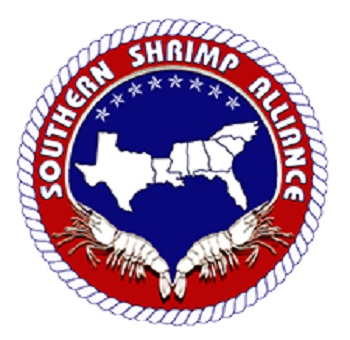
North Carolina Fisheries Association Membership, Southern Shrimp Alliance Needs Your Help!
As indicated below, the U.S. International Trade Commission has now issued questionnaires in its sunset review proceeding to the U.S. shrimp industry, U.S. shrimp importers, U.S. shrimp purchasers, and exporters and processors in the Chinese, Indian, Thai, and Vietnamese shrimp industries. The responses to these questionnaires, which are due on or before February 6, 2023, will provide the basis for the Commission’s analysis as to whether to keep the antidumping duty orders on Chinese, Indian, Thai, and Vietnamese shrimp in place for another five years. Thank you, in advance, for your assistance in meeting the U.S. International Trade Commission’s request for information. >Click to read, and access links< 13:11

North Carolina Fisheries Association Weekly Update 01/09/2023 – Fisheries Monitoring and Data Collection/Legislative Update
The number of commercial fishermen in North Carolina has definitely been on a downward trend for some time. We have gone from 4,588 active commercial licenses in 2001 down to 2,170 active licenses in 2021 according to DMF’s most recent statistics. Although numbers of participants in our state have decreased by almost half in the last 20 years commercial fishing monitoring and data collection has not and NC commercial fishermen continue to provide a wealth of useful data that has created a permanent record showing where we came from and how we got there. The first commercial fishing data collection system I will talk about is the North Carolina Division of Marine Fisheries (DMF) fish house trip ticket program. This program started in 1994 and since then it has grown into one of the leading fisheries data collection programs in the country. >click to read the update< 12:20
North Carolina Fisheries Association Weekly Update 01/09/2023
Fisheries Monitoring and Data Collection
 Commercial fishing and recreational fishing activities are both monitored by State and Federal agencies to account for harvested/landed fish, discarded/released fish, and also any threatened and endangered species interactions (both sectors do have interactions). This monitoring collects and provides data that fisheries managers use to monitor fish stocks and develop fisheries management plans (FMPs). And in most cases this data weighs heavily on the overall number of fish that everyone is allowed to annually harvest also known as the total allowable catch (TAC).
Commercial fishing and recreational fishing activities are both monitored by State and Federal agencies to account for harvested/landed fish, discarded/released fish, and also any threatened and endangered species interactions (both sectors do have interactions). This monitoring collects and provides data that fisheries managers use to monitor fish stocks and develop fisheries management plans (FMPs). And in most cases this data weighs heavily on the overall number of fish that everyone is allowed to annually harvest also known as the total allowable catch (TAC).
The number of commercial fishermen in North Carolina has definitely been on a downward trend for some time. We have gone from 4,588 active commercial licenses in 2001 down to 2,170 active licenses in 2021 according to DMF’s most recent statistics. Although numbers of participants in our state have decreased by almost half in the last 20 years commercial fishing monitoring and data collection has not and NC commercial fishermen continue to provide a wealth of useful data that has created a permanent record showing where we came from and how we got there.
The first commercial fishing data collection system I will talk about is the North Carolina Division of Marine Fisheries (DMF) fish house trip ticket program. This program started in 1994 and since then it has grown into one of the leading fisheries data collection programs in the country. All persons/businesses buying fish in North Carolina must obtain a dealer’s license and use this reporting system.
The fish house trip ticket program collects information on the fisherman, the fish dealer, date, number of crew, area fished, gear used, and quantity of each species landed for each trip. The DMF requires fish houses to send in these reports monthly and they must reach the Morehead City office no later than the 10th of the following month. It must also be noted, this past season fish houses were also required to report southern flounder landings daily during the open commercial flounder seasons.
For accountability in the fish house trip ticket program, DMF sends marine patrol officers to check for compliance and to make sure the numbers of fish in the coolers match with the trip tickets and also with records of fish sold to markets. If there are issues with numbers not adding up or fish were bought and sold during a closed season citations will be issued.
North Carolina DMF has also had a commercial fishing observer program since 2000. This program was expanded in 2010 as required by our incidental take permit (ITP) to observe a minimum of 7% with a goal of 10% observer coverage for all commercial fishing trips using anchored large mesh gill net and a minimum of 1% with a goal of 2% for all trips using anchored small mesh gill nets. If this coverage is not met commercial risk losing access to using this gear. Also, if fishermen do not comply with observer requests, they will receive a citation which could lead to a temporary suspension of their license or even a permanent termination of license. DMF also is required to send an annual report to NOAA Fisheries detailing this observer coverage and all incidental takes of sea turtles.
DMF also has a fish house sampling program. This program sends fishery technicians to fish house to collect data on commercial species caught as they are unloaded to be sold. In addition to species harvested, the technicians all collect their size and weight, where they were caught, and gear used. They also examine age structures from some of these samples.
Another program used to collect commercial fishery data in NC is the National Observer Program (NOP). Federal fisheries observers originally began going on commercial fishing vessels in the 1970s, but most recently in 1999 the National Marine Fisheries Service (NMFS) established the NOP to streamline their usefulness and set standards that allow for more uniform data collection across regions which has allowed the program to grow to what we see today.
The federal observer programs in North Carolina are all a bit different. Priorities change annually in these programs, but before COVID-19 and the recent large increase in required observer coverage in the North East Atlantic fisheries, commercial gill net fishermen in North Carolina completed hundreds of federally observed gill net trips annually. In 2019, 21.8% of my personal gill net trips, I had a federal observer on my boat. Observers on these trips measure and weigh hundreds of individual fish and also document discarded fish, they even take a few Otolith (Otoliths, commonly known as “earstones,” are hard, calcium carbonate structures located directly behind the brain of bony fishes) samples. Federal observers also hold the power to have vessels tied to the dock if fishermen do not comply with these mandatory observer coverage requirements.
North Carolina based pelagic longline boats with a tuna, swordfish, and shark tri-pack permits are required to have 2 cameras on board that record all hauls. This is 100% video observation coverage, when the hydraulic pumps power on, so do the cameras. These boats are also required to have a vessel monitoring system which tracks their position 24/7. And they are also required to report any Bluefin Tuna interactions within 12 hours after the haul back when the fish was caught. Human observers also still take trips with these vessels as well covering 7-10% of annual hauls further validating this data.
North Carolina commercial fishermen participating in the scallop fishery also have vessel monitoring systems to track their vessels. In regards to their federal observer program, the vessels are required to call in weekly to declare their intent to work and if chosen to carry an observer it is also the vessels responsibility to call and setup a day or days to carry an observer ahead of time. Another item to note is that the scallop observer program is industry funded. Each year 1% of the annual catch limit is set aside to help pay for this program.
In the limited entry federal snapper/grouper fishery North Carolina commercial fishermen also must carry observers to document their catch and discards. A recent announcement from NOAA Fisheries has increased observer coverage to 2.75% of the fleet’s overall effort (increased coverage began May 1st 2022). The information gathered is used to verify logbook catch rates, counts of discarded fish, and the catch per unit effort.
All commercial fishermen who participate in any federally managed fishery are also mandated to fill out at least one logbook. The Greater Atlantic Regional Fisheries Office (GARFO) logbook began in 1978 for boats participating in the surf clam fishery, but most North Carolina commercial fishermen began filling out this logbook in 1994 when GARFO required reporting for all vessels holding any Northeast Region permit.
The Southeast Fisheries Science Center (SEFSC) logbook program began in 1986, originally monitoring commercial vessels targeting pelagic species and then in 1990 it was expanded to monitor commercial snapper grouper vessels. In 1993 the SEFSC logbook again expanded to include the commercial shark fisheries and finally in 1999 commercial king and Spanish mackerel fisheries were added.
Many North Carolina commercial fishermen are lucky enough to be under two or more regional management areas and therefore many of us get to fill out multiple logbooks. Along with filling out the standard required logbooks commercial fisherman also get randomly selected to have to fill out a daily economic survey and/or a daily discard log book for the South East Fisheries Office (SERO). I for one have to do two logbooks every trip and I have also had one year when I was filling out the discard logbook and economic survey as well.
These logbooks collect a lot of detailed information including fisherman name, vessel name, date of trip start/end, exact time of trip start/end, number of crew, buyer information, state trip ticket reference number, gear specifics, pounds of each fish species harvest, number of each species discarded, fishing location, and depth fished. Economic surveys record gallons of fuel used, price per gallon, bait expense, ice expense, grocery expense, miscellaneous expense, purchased quota expense, trip sales, and hired crew/captain expense.
North Carolina fish houses who purchase fish harvested by federally permitted commercial fishing vessels must also have a federal dealers license. Again, since we are a state under multiple regional management areas many fish houses in our state must have multiple federal dealers permits. Reporting requirements vary but for most species in the Greater Atlantic region reporting is required weekly.
As all of these commercial federal logbooks and dealer permits are mandatory there are penalties for non-compliance. These penalties include not allowing you to renew your permit until all trip logs have been received, suspending your permit for non-compliance in season, all the way to be federally prosecuted for falsifying documents. Generally, if you enter information incorrectly or leave boxes blank or miss a trip, they will send these reports back for you to correct. Thanks to dual reporting from the fish houses, they know if you mixed up one species weight with another or simply did not fill out a log for one trip.
All of this redundancy leads to accurate and precise commercial harvest data. Having so many data gathering and monitoring programs that account for every single fish observed on a haul allows fish managers a good picture of most commercial fisheries. And with such good baseline data, mathematical extrapolations in the commercial fishery can also be more accurate and precise. We know the number of participants, we know what they catch, we know what they discard, therefore we have a good idea of what they have the potential to catch. Good data equates to good management.
The timelines of the data received from commercial fishermen and fish dealers also helps fisheries managers close fisheries when quotas are projected to be met. Managers use past and current landings trends to project when commercial quotas are going to be met and usually announce closures days or weeks in advance. This helps protect our fish stocks from overfishing.
Fisheries data collection in North Carolina is some of the best in the country and I am sure I missed plenty of other commercial fishing data sources in this update as well, such as fisheries research work done by the commercial industry. In a future update I’m hoping to document North Carolina’s recreational sector fisheries monitoring and data collection and do a comparison between the two. If you have any input on commercial or recreational monitoring and data collection please reach out.
Thomas Newman
Fisheries Liaison
LEGISLATIVE UPDATE: 1.9.2023 GENERAL ASSEMBLY
I hope everyone had a very delightful holiday season!
The NC Senate and House members will be sworn in this Wednesday, but the legislative work won’t begin in earnest for a while. The members’ email addresses are posted on their website but room and committee assignments have not been completed.
I attended swearing in ceremonies for Senator Norman Sanderson and Representative Keith Kidwell last Tuesday in Pamlico County and Thursday in Hyde County. I was hoping to make it to Dare County also on Thursday afternoon but that didn’t work out. I was able to visit Newman Seafood and Hobo Seafood in Swan Quarter.
God bless, and Happy New Year!
Jerry

North Carolina Fisheries Association Weekly Update for 11/21/2022 – NCMFC Votes More Apples for Me!
Last week I attended the November 2022 business meeting of the NC Marine Fisheries Commission (MFC) and below are my thoughts on a couple of key issues on their agenda. Bear in mind I have not gone back and listened to the meeting, so I am relying solely on my recollection from last week. Thankfully, it’s only been a couple of days so my percent standard error (PSE) should be much lower than the bi-monthly mail survey the State used to estimate the recreational harvest of Stiped Mullet! Night one of the meetings began at 6pm with comments from the public, mostly recreational anglers and mostly focused on one issue, the net ban in the Upper Neuse and Pamlico Rivers. >click to read the weekly update< 12:08
North Carolina Fisheries Association Weekly Update, 11/21/2022 – North Carolina MFC Votes More Apples for Me!
North Carolina MFC Votes More Apples for Me!
Last week I attended the November 2022 business meeting of the NC Marine Fisheries Commission (MFC) and below are my thoughts on a couple of key issues on their agenda. Bear in mind I have not gone back and listened to the meeting, so I am relying solely on my recollection from last week. Thankfully, it’s only been a couple of days so my percent standard error (PSE) should be much lower than the bi-monthly mail survey the State used to estimate the recreational harvest of Stiped Mullet!
Night one of the meetings began at 6pm with comments from the public, mostly recreational anglers and mostly focused on one issue, the net ban in the Upper Neuse and Pamlico Rivers. The takeaways from the recreational comment were, North Carolina fisheries have gone to hell in a handbag, (except for the Upper Neuse and Pamlico thanks to the net ban) the States to our South have fisheries management figured out, and more net bans will equal more fish. None of which is supported by data, but neither was the implementation of the net ban, or the results of several recent stock assessments so, why should that matter? After public comment, Woody Joyner, President of NC Waterman United, and I were discussing the commenters assertion that since the net ban the fishing had improved. I told Mr. Joyner that, unlike most of their claims, this one may be true and used the following analogy to explain.
Imagine that Mr. Joyner and I share a property line and, on that line, stands an apple tree. Mr. Joyner and I have a gentleman’s agreement that all the apples on his side of the tree are his and those on my side are mine, and for years we both enjoy an abundant harvest. Then, one year I hire a surveyor to survey my property and it’s determined that the apple tree is entirely within the boundaries of my property and new lines are drawn. Now, simply drawing a line Mr. Joyner couldn’t cross did not increase the amount of fruit on that tree, but it did, without a doubt, mean more apples for me!
Simply put, both the intent and result of removing the nets were reallocation, “more apples for me”, nothing more. This conclusion was supported by comments from both members of the Commission and DMF staff the following day. Division staff concluded that the angler’s perception of more fish was most likely just more fish for me and the result of them now catching, the fish they had traditionally caught in addition to the fish traditionally caught by commercial fishermen, not increased abundance. DMF staff also pointed out that in the 3+ years since the implementation of the net ban and harvest moratorium, data collected from the independent gill net survey, has shown no expansion of either the abundance of Striped Bass or the age structure of the stock. In fact, as I recall these indices were now the lowest, they’ve ever seen.
In response to their comments, MFC Chairman Rob Bizzell questioned whether they would normally see increases in abundance and age structure in just 3 years and quite frankly I was disappointed in the response or lack thereof. The truth is, abundance is directly affected by recruitment (reproduction) which is highly dependent on environmental factors and therefore is almost impossible to predict or manage, the same cannot be said for age structure. Age structure is a direct result of the survival of existing fish, in this case two strong year classes of Striped Bass which were three to four years old at the time the net ban was adopted. Each year these fish survive increases the age structure by one year meaning, if the management actions increased the survival rate, 3+ years of management would have resulted in the age structure expanding to include fish of 6-8 years of age.
If the nets were the problem, where are the older fish?
With the nets out of the water, recreational catch and release mortality has to be the dominant source of mortality, as all harvest has been eliminated and natural mortality decreases with age. Unfortunately, these points were not driven home by the Division.
To sum it up, in 2019 the data provided to the Commission pointed to recreational discard mortality being more significant than gill net discards and the data collected since, certainly seems to support that conclusion.
Despite all of the information suggesting that the net ban has not increased survival in this fishery and was never supported by science in the first place the MFC chose to extend the net ban two more years claiming more data was necessary to assess the results. That’s right, the Commissions approach is to remove the nets in hopes that somewhere down the road the data will justify their actions!
So much for fair management!
Another issue of great importance to commercial fishermen was taken up by the Commission last week, the supplement to the Striped Mullet FMP. On this issue the data was not nearly as clear as with the net ban.
In fact, the most recent stock assessment for Striped Mullet which indicated the stock was overfished with overfishing occurring is, in my opinion, as data poor as any assessment I’ve seen. This probably explains the dramatic difference in results from the assessment completed just 4 years earlier which showed the stock was not experiencing overfishing. You’re probably thinking that it’s entirely possible that overfishing could have occurred over the 4-year period between assessments and, if so, you’d be right but that’s not what the recent assessment shows. The new assessment shows that there is a 80% probability that overfishing has been occurring for nearly two decades. You’re probably wondering how four new years of data changed the stock status for two decades and you’re not alone. After looking at the assessment, my best guess is that it’s not the last four years of data but the overall quality, or lack thereof, of the data that’s creating the high degree of uncertainty. While the drastic difference in the results of these two stock assessments has certainly raised some eyebrows, even more concerning is the fact that the most recent assessment results don’t seem to match what’s occurring in the fishery. Fishermen are reporting more and larger mullet in our states waters and commercial landings are increasing. According to Division staff, their independent surveys also seem to be showing signs of improvement which is telling to me given the extreme limitations of these surveys. I’ve always said that a high degree of uncertainty should always slow down decision making, not speed it up, but with fisheries management, at least here in NC, that’s seldom the case.
The Commission ignored the uncertainty, choosing not to look at the most recent three years of data before acting, and voted to close the harvest of Striped Mullet on November 7, 2023, through the end of that year, a 22% reduction in commercial harvest. This season closure will remain in place until an Amendment to the FMP has been approved, at which time it can be incorporated as part of the amendment or replaced by other management measures.
On the net ban issue there was absolutely no data to support the adoption or continuation of the measure, but the Commission moved forward with both, supposedly in search of new data. On the other hand, with Striped Mullet, there was already new data, suggesting things aren’t as bad as the stock assessment showed, but they chose not to consider any new data and, once again, cut commercial access to our fisheries resources. Damned if we do and damned if we don’t!
It’s obvious to me that a majority of this Commission has a much different interpretation of our states statutes than I do, or they have chosen to ignore those statutes and arbitrarily regulate based solely on their own will. Maybe an interpretation of those statutes is necessary to clear up this confusion.
Fortunately, there are those Commissioners who are trying to fairly manage our fisheries, despite being outnumbered and constantly attacked. One such Commissioner, Sarah Gardner, made it clear that she intended to do the right thing no matter what the cost. Her passionate words gave new meaning to the outdated phrase “the fairer sex” and shined, much needed, light on the true issues hampering North Carolinas fishery management process. I applaud her nerve and conviction and encourage all Commissioners to follow her example.
Unfortunately, the personal attacks against her have already begun and will certainly continue until she complies with the CCA agenda or quits. I urge Sarah to hang in there, stick to her guns, follow her heart, and avoid the more apples for me mentality!
Glenn Skinner
NCFA-Executive Director
LEGISLATIVE UPDATE: 11.21.2022
GENERAL ELECTION RESULTS
The computer files for the NC General Assembly have been updated to reflect the results of the recent election. Next will be the addition of email addresses and committee assignments but that info won’t be available for several weeks. In the meantime, we attempt to get into holiday mood, as in happy, jolly and positive. That is difficult if you’re in the fish business, but spiritually important. It would help our attitudes greatly if the Marine Fisheries Commission didn’t meet so close to Thanksgiving. That crowd can sure take the jolly out of an otherwise joyous season.
Regardless, there’s much to be thankful for!
God bless, and Happy Thanksgiving!
Jerry

North Carolina Fisheries Association Weekly Update for November 14, 2022
November 2022 NC Marine Fisheries Commision Meeting – The MFC meeting is being held in Emerald Isle, NC November 16th-18th at the Islander Hotel (102 Islander Dr, Emerald Isle, NC 28594). The 2022 election is now history and it’s time to begin updating the contact information for the US Senate & House and the North Carolina General Assembly. >click to read the meeting agenda, and the update< 14:44

North Carolina Fisheries Association: Weekly Update for October 10, 2022
Last Tuesday evening (October 4,2022) I attended a striped mullet scoping meeting where staff from the NC Division of Marine Fisheries (DMF) were seeking stakeholder input for the future management of the mullet fishery. DMF staff certainly got an ear full of “input”, mostly in the form of questions and comments about the most recent Striped Mullet Stock assessment. The 2022 Striped Mullet assessment, which used data through 2019 indicated that overfishing is occurring, and that North Carolinas Striped Mullet stock is overfished, and apparently has been for two decades or more. This came as a shock for the fishermen in attendance for a couple of reasons. ->Click here to read the Weekly Update<, to read all the updates >click here<, for older updates listed as NCFA >click here< 12:32
North Carolina Fisheries Association
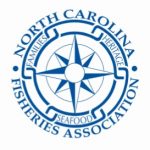 Last Tuesday evening (October 4,2022) I attended a striped mullet scoping meeting where staff from the NC Division of Marine Fisheries (DMF) were seeking stakeholder input for the future management of the mullet fishery. DMF staff certainly got an ear full of “input”, mostly in the form of questions and comments about the most recent Striped Mullet Stock assessment. The 2022 Striped Mullet assessment (Click Here to Open), which used data through 2019 indicated that overfishing is occurring, and that North Carolinas Striped Mullet stock is overfished, and apparently has been for two decades or more. This came as a shock for the fishermen in attendance for a couple of reasons.
Last Tuesday evening (October 4,2022) I attended a striped mullet scoping meeting where staff from the NC Division of Marine Fisheries (DMF) were seeking stakeholder input for the future management of the mullet fishery. DMF staff certainly got an ear full of “input”, mostly in the form of questions and comments about the most recent Striped Mullet Stock assessment. The 2022 Striped Mullet assessment (Click Here to Open), which used data through 2019 indicated that overfishing is occurring, and that North Carolinas Striped Mullet stock is overfished, and apparently has been for two decades or more. This came as a shock for the fishermen in attendance for a couple of reasons.
First, for the last two to three years, which were not included in the assessment, fishermen have been seeing increasing numbers of mullet in our state waters leading many to believe the stock is expanding. Second, and even more concerning, is the fact that the last assessment, completed in 2018, which used data from 1994 to 2017 indicated that overfishing was not occurring, and the stock was not overfished, nor had it ever been.
That’s right, in just four years the stock went from never having been “overfished” to now having been “overfished” for decades! As you might imagine, this has left many fishermen frustrated and questioning how this is even possible.
Afterall, we only have two years of new data since the last assessment. How can two years of commercial harvest data and DMF sampling change the stock status for two decades? The short answer is that two additional years of data and the stock status aren’t the only things that have changed.
The first Striped Mullet stock assessment was completed in the early 2000’s, during the development of the Striped Mullet Fishery Management Plan (FMP), using data from 1994-2002 and concluded that overfishing was not occurring. In 2013, the “Benchmark Assessment” was completed using the same assessment model as the previous assessment and updated data from 1994-2011 and, once again, it was determined that overfishing was not occurring.
Now, common sense would suggest that once a stock assessment was completed, peer reviewed, and accepted for management that the same sources of data, overfishing thresholds/targets, and assessment models would be used for future reviews, with the only new information being the most recent years of data. Unfortunately, common sense evidently has no place in the world of fisheries management.
Since the 2013 benchmark assessment, one Amendment and two assessments have been completed, resulting in new overfishing targets/thresholds, the exclusion of multiple sources of data, an extended time series (1950-2019) and a dramatic change in stock status. It may be hard for you to believe that these seemingly insignificant changes can have such a dramatic impact on abundance estimates, but it can, and this isn’t the first time it’s happened!
In 2009, DMF completed the Spotted Sea trout (Speckled Trout) stock assessment which indicated that the fishery had been overfished with overfishing occurring for the entire time series (1991-2006), 18 years.
An update of that assessment which included data from 2007 and 2008 resulted in the same conclusion, overfished and overfishing for 20 years, at least, possibly longer if they had included data prior to 1991. The results of this stock assessment, which was peer reviewed and accepted for management, led to the adoption of strict harvest reductions (40%) for both commercial and recreational sectors, through the FMP in 2012.
Three short years later, in 2015, another assessment was completed. This new assessment utilized a different computer model, changed the fishing year from a calendar year to a biological year (March 1- February 28), decreased the maximum age of Speckled Trout from 12 to 9, and added new tagging data, which according to DMF did not have a significant influence on results.
Once again, a few, seemingly minor, changes to the assessment produced radically different results. The Speckled Trout stock, which had previously been overfished for at least two decades was now not overfished or experiencing overfishing and never had been, not even for the two decades from 1991-2008!
You’re probably thinking at least this drastic change was a positive one. Afterall, if the stock isn’t overfished there’s no further need for the 40% harvest reduction.
Right? Wrong!
Ten years later and the strict harvest reductions meant to rebuild a stock which had been overfished for two decades are still in place despite the new determination that the stock has never been overfished!
It’s no wonder that the fishermen who attended the mullet scoping meeting were so frustrated, they’re damned if they do and damned if they don’t. With such drastic changes from one assessment to another, how can anyone commercial, recreational, consumer, or scientist have any faith in these results?
Would a couple of minor changes to the Southern Flounder assessment have saved us from these draconian 72% harvest reductions?
From what I’ve seen I’d say absolutely!
The question is, which assessment is right? If any!
Should we have used data from 1994-2019 or 1950-2019? Should the overfishing threshold be raised or lowered?
How long do Speckled Trout live? (I found ranges from 8 years to 18 years) Do mature Southern Flounder return to NC estuaries after spawning or remain offshore?
Unfortunately, I don’t have the answers to these questions and, to be frank, it doesn’t appear that anyone else does either. What I do know is that the decisions DMF staff make have a dramatic impact on these assessments and the citizens of this State. I also know that our states statutes and outside pressures often force them to take action even when uncertainty is extremely high.
That said, we deserve better and should demand better and I firmly believe the State can do better for all stakeholders not just a fortunate few.
Glenn Skinner
NCFA-Executive Director

North Carolina Fisheries Association Weekly Update September 12, 2022
For decades now, the CCA has done their best to turn “bycatch” into a four-letter word, especially commercial bycatch. They’ve used the term “bycatch” to justify their failed attempts to enact net bans and gamefish bills! They’ve used the term “bycatch” to justify banning shrimp trawling in North Carolina! They’ve used the term “bycatch” to justify almost every current restriction on commercial fishermen and commercial fishing gear! >click to read<. To read all the updates >click here<, for older updates listed as NCFA >click here< 09:18
North Carolina Fisheries Association Weekly Update September 12, 2022
 Below is a call to action sent out by David Sneed, Executive Director of the Coastal Conservation Association of NC (CCA), asking anglers to attend next weeks meeting of the South Atlantic Fishery Management Council and oppose proposed measures to rebuild the overfished Red Snapper stock. The measures opposed by the CCA, time and area fishing closures and the implementation of a federal reef fish permit, are meant to reduce mortality and improve the understanding of recreational effort in the Red Snapper fishery, which the most recent assessment suggests is overfished with overfishing occurring.
Below is a call to action sent out by David Sneed, Executive Director of the Coastal Conservation Association of NC (CCA), asking anglers to attend next weeks meeting of the South Atlantic Fishery Management Council and oppose proposed measures to rebuild the overfished Red Snapper stock. The measures opposed by the CCA, time and area fishing closures and the implementation of a federal reef fish permit, are meant to reduce mortality and improve the understanding of recreational effort in the Red Snapper fishery, which the most recent assessment suggests is overfished with overfishing occurring.
CALL TO ACTION
The South Atlantic Fishery Management Council meets next week in Charleston and two items on the agenda are of particular significance to offshore anglers. In Snapper Grouper Fishery Regulatory Amendment 35, NOAA Fisheries is attempting to force massive time and area closures that would result in severe, negative economic and cultural impacts to recreational fishing, boating, and coastal communities in the South Atlantic in order to prevent red snapper mortality even as bycatch. While the red snapper population is now regarded as abundant as it has ever been in modern times, NOAA Fisheries is insisting that more severe restrictions are necessary to rebuild the population to a fully recovered status. According to NOAA Fisheries, that status cannot be bestowed until older fish – 30, 40 and even 50 years old – are present in the population, which means these severe restrictions could be in place for decades.
Coastal Conservation Association has urged caution during the recovery of red snapper from historic lows, but is objecting to the massive closures as completely misguided in the face of a booming red snapper population. Among the many objections to the current proposal:
1. An independent assessment of the red snapper population is now underway – CCA is urging the Council to delay any decisions until the results of that assessment are known and verified. A similar assessment in the Gulf of Mexico produced a completely new understanding of the red snapper population there.
2. Recreational discard data is perhaps the least reliable in the entire management system, relying solely on angler recall and interpretation. New data collection systems – designed and managed by the states – are desperately needed for more timely and accurate estimates.
3. Federal fisheries management must be reformed to address the absurdity of a stock being declared above historic abundance, yet still being classified as overfished and undergoing overfishing, and therefore subject to wildly inappropriate regulations.
The other related item up for discussion next week is Snapper Grouper Amendment 46, which is exploring implementation of a federal reef fish permit. CCA has long supported better data and efforts to define the universe of anglers for improved management. As noted above, there is a critical need for more accurate and timely estimates of the recreational catch and discards. However, NOAA Fisheries track record of recreational management is exceptionally poor.
If a mechanism is needed to improve recreational data in the South Atlantic, CCA is urging South Carolina, North Carolina and Georgia to join Florida in creating state-based systems to provide more timely and accurate data for management of the recreational sector. Nothing in NOAA Fisheries management history of the recreational sector indicates a federal permit will produce the desired results or be used entirely as originally intended. Given recent comments from federal managers, CCA is concerned such a permit in federal hands will eventually be proposed to limit entry in the recreational fishery.
The South Atlantic Fishery Management Council is meeting Sept. 12-16 at the Town & Country Inn, 2008 Savannah Highway Charleston, South Carolina. The public can make comments to the Council at 4 p.m. on Wednesday, Sept. 14. The public may also submit online comments HERE.
In the CCA’s call to action, Sneed states “NOAA Fisheries is attempting to force massive time and area closures that would result in severe, negative economic and cultural impacts to recreational fishing, boating, and coastal communities in the South Atlantic in order to prevent red snapper mortality, even as bycatch.”
Even as bycatch! Really?
For decades now, the CCA has done their best to turn “bycatch” into a four-letter word, especially commercial bycatch.
They’ve used the term “bycatch” to justify their failed attempts to enact net bans and gamefish bills! They’ve used the term “bycatch” to justify banning shrimp trawling in North Carolina! They’ve used the term “bycatch” to justify almost every current restriction on commercial fishermen and commercial fishing gear! They’ve used the term “bycatch” to justify their constant support for draconian harvest reductions for both the commercial and recreational sectors! They’ve used the term bycatch to divide the recreational and commercial communities, turning neighbor against neighbor!
But now they have the nerve to say “even as bycatch” as if the CCA has no concerns at all over bycatch.
Why?
The truth is, the CCA uses terms like overfished, overfishing, cryptic mortality, overharvest, and bycatch to push for reduced harvest for both commercial fishermen and recreational anglers because it benefits them not the resource.
Need proof? Well, here it is!
In the late 90’s the CCA pushed for strict recreational and commercial restrictions in the Red Drum fishery which led to the current, 18–27-inch slot limit, 250,000 lb. annual commercial harvest cap, gill net attendance requirements, and 1 fish daily recreational bag limit. Over two decades later, these restrictions remain in place mostly due to a lack of data, not lack of fish. But rather than push for better data collection or discourage anglers from targeting these fish until the stock is deemed recovered, the CCA encourages anglers to target Red Drum, even the spawning stock, going so far as to hold fishing tournaments for this supposedly imperiled stock.
The CCA took a similar position on the management of Striped Bass where they supported strict harvest reductions, even a 10-year harvest moratorium, but opposed area or seasonal closures to prevent the targeting of Striped Bass on their spawning grounds. Once again, the CCA encourages anglers to target an “overfished”, stock, even on the spawning grounds, and holds fishing tournaments targeting Striped Bass despite the fact that recreational dead discards have become one of the dominant sources of Striped Bass mortality.
CCA NC Inside/Out Catch and Release Fishing Tournament | iAnglerTournament
The same strategy was used, by the CCA, in the Southern Flounder fishery where they pushed for, and received, a 72% harvest reduction resulting in a harvest quota for both the recreational and commercial sectors based on total removals (harvest and dead discards), paybacks for quota overages, short harvest seasons and a 1 flounder daily recreational bag limit.
While many anglers patiently wait for the flounder harvest season to open, others, encouraged by the CCA, target Southern Flounder outside of the harvest season, participating in the CCA’s catch and release tournament, increasing dead discards which count against the already low recreational quota!
CCA NC 2022 Inshore Open | iAnglerTournament
Holding fishing tournaments for “overfished” species, targeting the spawning stock, and increasing waste through increased recreational dead discards doesn’t sound like “conservation” does it?
The truth is, the CCA only supports the “conservative” approach when it results in a direct reduction in harvest and increased access/allocation for themselves, the catch and release sector.
Still not sure? Let’s take a look at Red Snapper.
The CCA seems to have no issue with a 2-to-3 day recreational harvest season and 1 fish daily bag limit for Red Snapper but opposes time and area closures to decrease “bycatch” removals in the form of dead discards. According to NOAA Fisheries data, in the 5-year time period from 2015-2019 91,300 Red Snapper were removed through recreational harvest and 2,803,280 Red Snapper died as a result of recreational dead discards.
That’s right, waste, or recreational dead discards of Red Snapper exceed recreational harvest by more than 30x, but the CCA is willing to jeopardize all recreational harvest and the stocks potential to fully recover just to protect their ability to catch and release fish.
What a privileged group they must be to proclaim a memory is more valuable than a meal!
The CCA argues that “recreational discard data is perhaps the least reliable in the entire management system, relying solely on angler recall and interpretation.”
Of course, the same could be said for all of the fisheries mentioned above, but it never was, at least not by the CCA. When recreational discard data, as unreliable as it certainly is, is used to reduce harvest the CCA quickly becomes a champion of the resource, demanding that managers ignore the economic consequences and manage solely for the resource.
But, when the shoes on the other foot and catch and release access is threatened, they shift from conservationist to capitalist begging managers to consider the “severe, negative economic and cultural impacts to recreational fishing, boating, and coastal communities.”
The sad truth is, the CCA speak for themselves not the resource and while their message seeks to hide this truth their actions clearly expose their true agenda. Another sad truth, is fisheries managers across this country have, for the most part, ignored the impacts of “sport fishing” and the countless millions of dead and wasted fish that have fallen victim to the catch and release “conservation strategy.”
Now let me be clear, I’m not opposed to catch and release fishing, fishing for personal consumption or commercial fishing, they all have their place. That said, the law requires fair and equitable management of our fisheries and that cannot be accomplished until all sources of mortality, even catch and release mortality, are addressed and all stakeholders feel the sting of management, not just those who harvest fish.
Until managers reject this modern concept of “conservation” and address the impacts of recreational discard mortality the concepts of sustainable fisheries and fair and equitable management are nothing more than a farce.
The CCA’s strategy reduces harvest, increases mortality and waste, slows or even prevents rebuilding, and assures unprecedented and unlimited access to the privileged few who fish solely for fun, not food.
Once again, rules for thee, not for me!



































